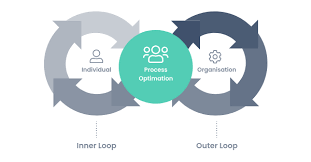The Importance of Feedback Loop in Improving Performance
Feedback loop is a crucial element in any system where performance improvement is desired. It involves the process of receiving feedback, analysing it, and implementing changes based on the insights gained. Whether in business, education, or personal development, a well-functioning feedback loop can lead to significant improvements and growth.
One key aspect of a feedback loop is the collection of feedback from various sources. This can include customer reviews, employee surveys, performance evaluations, and more. By gathering diverse feedback, organisations can gain a comprehensive understanding of their strengths and weaknesses.
Once feedback is collected, the next step is to analyse it effectively. This involves identifying patterns, trends, and areas for improvement. By extracting meaningful insights from the feedback received, organisations can make informed decisions on how to enhance their performance.
Implementing changes based on feedback is where the real impact lies. By taking action on the insights gained from the feedback loop, organisations can address issues proactively, innovate processes, and ultimately improve overall performance.
Continuous iteration is key to a successful feedback loop. By constantly collecting feedback, analysing it, and implementing changes, organisations can create a culture of continuous improvement that drives growth and success.
In conclusion, a well-established feedback loop is essential for driving performance improvement in any setting. By embracing feedback as a tool for growth and learning, organisations can adapt to changing environments, meet stakeholder expectations, and strive for excellence.
7 Essential Tips for Creating an Effective Feedback Loop
- Clearly communicate expectations and goals for feedback.
- Provide specific and actionable feedback rather than general comments.
- Encourage open communication and create a safe space for receiving feedback.
- Regularly follow up on feedback given to track progress and improvements.
- Offer constructive criticism along with praise to maintain a balanced feedback loop.
- Be receptive to receiving feedback yourself and demonstrate willingness to make changes based on it.
- Use technology tools effectively to streamline the feedback process and ensure timely responses.
Clearly communicate expectations and goals for feedback.
In order to establish an effective feedback loop, it is crucial to clearly communicate expectations and goals for feedback. By outlining what specific areas or aspects you are seeking feedback on, as well as the intended outcomes of the feedback process, you can ensure that respondents provide relevant and actionable insights. Setting clear expectations helps both parties understand the purpose and scope of the feedback exchange, leading to more meaningful and constructive feedback that can drive positive changes and improvements.
Provide specific and actionable feedback rather than general comments.
To maximise the effectiveness of a feedback loop, it is essential to provide specific and actionable feedback rather than general comments. Specific feedback offers clear guidance on what needs improvement and how to achieve it, enabling individuals or organisations to make targeted changes. By providing actionable suggestions, recipients can easily understand how to implement the feedback and work towards tangible improvements. This approach fosters a culture of continuous learning and development, leading to enhanced performance and growth.
Encourage open communication and create a safe space for receiving feedback.
Encouraging open communication and fostering a safe space for receiving feedback are vital components of a successful feedback loop. By promoting an environment where individuals feel comfortable expressing their thoughts and opinions without fear of judgement or repercussions, organisations can cultivate honest and constructive feedback. This approach not only enhances transparency and accountability but also empowers individuals to share valuable insights that can drive meaningful improvements and foster a culture of continuous learning and growth.
Regularly follow up on feedback given to track progress and improvements.
Regularly following up on feedback given is a crucial step in ensuring that progress and improvements are tracked effectively. By consistently monitoring the outcomes of implemented changes based on feedback, organisations can gauge the impact of their efforts and make necessary adjustments to further enhance performance. This proactive approach not only demonstrates a commitment to continuous improvement but also fosters a culture of accountability and responsiveness to feedback, ultimately leading to sustained growth and success.
Offer constructive criticism along with praise to maintain a balanced feedback loop.
To maintain a balanced feedback loop, it is essential to offer constructive criticism along with praise. While acknowledging achievements and strengths is important for motivation and morale, providing constructive feedback on areas for improvement is equally crucial for growth and development. By offering a blend of praise and constructive criticism, individuals can receive a well-rounded perspective on their performance, enabling them to make meaningful adjustments and progress towards their goals effectively. This balanced approach fosters a culture of continuous improvement and ensures that feedback remains valuable and actionable.
Be receptive to receiving feedback yourself and demonstrate willingness to make changes based on it.
To fully harness the benefits of a feedback loop, it is imperative to adopt a receptive attitude towards receiving feedback and demonstrate a genuine willingness to implement changes based on the insights gained. By remaining open-minded and proactive in responding to feedback, individuals and organisations can foster a culture of continuous improvement and growth. Embracing feedback as a valuable tool for personal and professional development not only enhances performance but also cultivates stronger relationships built on trust and mutual respect.
Use technology tools effectively to streamline the feedback process and ensure timely responses.
To maximise the effectiveness of the feedback loop, it is essential to leverage technology tools efficiently. By utilising appropriate platforms and software, organisations can streamline the feedback process, making it easier to collect, analyse, and act upon feedback in a timely manner. Technology tools can automate feedback collection, provide real-time insights, and facilitate prompt responses, enabling organisations to address issues swiftly and enhance performance effectively. Embracing technology in the feedback loop not only improves efficiency but also fosters a culture of continuous improvement and responsiveness within the organisation.

